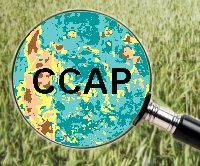Crop Condition Assessment Program

|
New in 2017, the Crop Condition Assessment Program (CCAP) has been redesigned to include each component of the application in a single screen, and is adapted to be used with portable devices equipped with small screens. |
Since the 2010 growing season, the CCAP has been enhanced with the integration of MODerate-resolution Imaging Spectroradiometer (MODIS) data (250-meter resolution) for the agricultural region of Canada and the northern half of the United States. The applications' common look and feel interface remains unchanged for ease of use and flexibility while using either the original 1-kilometer resolution based application or the enhanced 250-meter based application.
The CCAP is developed and maintained by Statistics Canada. Agriculture and Agri-Food Canada has partnered with Statistics Canada to provide this product free of charge to the public-at-large. The CCAP is the longest running, continuous crop monitoring program using Earth Observation data in Canadian history.
The CCAP is an interactive product that uses the 1,000-meter resolution digital data from the National Oceanographic and Atmospheric Administration (NOAA) series of satellites and the 250-meter MODIS digital data during the growing season to monitor the changing vegetation conditions on a 7-day cycle over the agricultural region of Canada and the northern half of the United States. This weekly interactive information package produces timely, quantitative and objective information on crop and pasture conditions at the census agricultural region / county, census division, census consolidated subdivision (municipality) and township levels. It includes colour images and maps, graphs and tables of current and historical conditions beginning at 1987.
Demands by private industry, grain marketing agencies, agri-business, and governments to produce accurate, timely production estimates well in advance of statistical survey estimates, have encouraged CCAP to include an experimental spring wheat yield forecast for western Canada as a useful tool for making management decisions.
- Date modified: